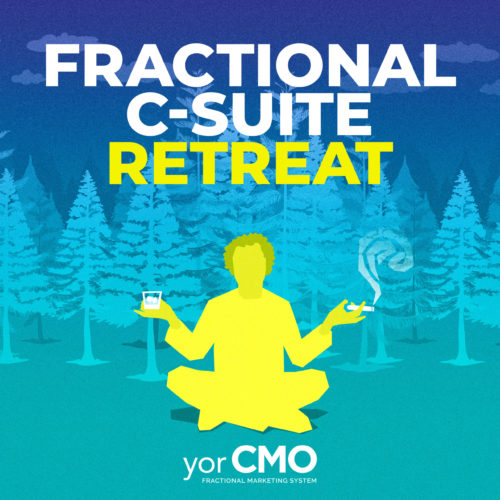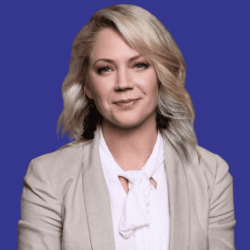As a lifelong marketer of technology products and services, fractional CMO Michael Carter experienced a multitude of changes within the marketing industry. Most significantly, over the years, he has had the unique benefit of watching marketing move from primarily print to primarily digital.
It’s a shift that has led marketing to become more data-driven by nature. But some business owners may find themselves overwhelmed by the sheer amount of data available and frustrated with their inability to get their ads seen or clicked.
But, according to Carter, utilizing data-driven marketing to your advantage is key for growth-minded CEOs. “Today, you have the ability to track performance and tie dollar investments to outcomes in ways that two decades ago we just didn’t,” he said. “It’s an entirely different game.”
Now that you can market in very discreet, specific, focused areas. To put it bluntly: “If you think your product is for everybody in the world, you’re probably in trouble.”
Instead, Carter says your marketing goal should become this: to seek out that perfect, most profitable match for your product and speak to them in a relevant way.
With the specificity and measurements available in digital marketing, you can now attract investments like never before, and, best of all, you can finally get clear on the actual ROI of your marketing efforts. That’s good news for anyone trying to sell something.
The Value Of Grunt Work
As a fractional CMO, Carter always performs an extensive audit at the beginning of any engagement. This part of the process, he says, is usually eye-opening for the business owners and CEOs he works with.
“They’re usually in a hurry. They’ve reached out to us because they need to up their game. They want to have an impact right now,” Carter said. “But if we don’t spend four or five weeks, doing a bit of work, we aren’t going to be able to make that impact, because we won’t have the data and the insights needed”.
A lot of people think ad creation or the other things they associate with marketing is the hard part, but the hardest part is actually all the research and work you need to do beforehand. The value of this grunt work can’t be underestimated.”
Often, when CEOs are making marketing decisions that seem to have little ROI, difficult ROI, or no ROI, this process helps them find out how they don’t truly understand the customer’s voice.
According to Carter, understanding the customer’s voice is incredibly hard and often overlooked. He suggests interviewing half a dozen customers or doing a customer survey. You’ll not only learn their language, but you’ll also learn how they acquire their information and what barriers you have to satisfy to meet them where they are.
Because, at the end of the day, if you don’t know your core customer, nothing else matters. You can’t grow your business; you can’t grow your cash. You have to know your customer.
Carter suggests that as you get to know your core customer, avoid simply referring to them by their demographics. Instead, “give them a name – Bob or John or Corey or Jenny – and find out what they do.” Ask: what are their struggles every day? What does an 8-to-5 look like for them?
Once you know your customer and their needs well enough, you have an edge over the competition. All you have to do is get in front of them and tell that story. Now you can start enhancing your business like never before.
Addressing The Ugly Baby In The Room
We all have confirmation bias around one thing, and for business owners, it’s often their “baby” (i.e. their business.) They love it and want to hear the good things about it. Nobody likes being told their baby’s ugly – even if they’re told customers are saying it – but there is an unspoken benefit to bringing in outside help to help with your business.
“As an employee, I was more careful telling my boss what I thought. But as a fractional CMO, it’s much easier,” Carter explained. “We’re not sensitive to who’s the boss. We’re here to help. If I don’t tell you the facts as I see them – what are you paying me for?”
Telling the truth might theoretically be what everybody on the team should do, but it’s usually not what happens. For the employees inside of an organization – who depend upon the work for ongoing paychecks and bonuses – it’s hard to feel comfortable saying, “Hey, that part of the baby’s a little ugly.” So while your employees may be reluctant to tell you the truth because it’ll affect their bonuses, fractional C-suite members bring the freedom and expertise to constructively disagree with you.
If a CEO hearing something negative about their business says, “Yeah, I don’t actually think that’s what the customer meant.” It becomes the marketing person’s job to stand up to the CEO and say, “Hey, man, this is my discipline, and this is what I’m hearing. You aren’t hearing it, and you need to pay attention.”
The Difference Between A Fractional Professional And A Full-Time Professional
“I’ve come to the conclusion that if I were running an early-stage company wanting to go larger, I would probably use the fractional model for a lot of my stuff,” Carter admitted.
He spoke of a friend who began their company with various fractional professionals – including a fractional CMO, fractional HR, fractional lawyer, and fractional CPA. The business grew and the evidence was clear: the fractional professionals were probably doing what they should be doing.
Part of the reason that fractional professionals perform so well is that there is a different level of accountability and expectations in fractional work. Fractional professionals have to perform and make a difference every single month, or else the CEO will lose confidence and the engagement will be ended.
And that’s one thing Carter loves about being a fractional CMO: “I’m a guy that wants to make a difference. I don’t want to get up and put it on autopilot. Because if it runs well on autopilot, you don’t need me.
As one of my mentors said, ‘You’re not good when you’re bored.’ I’m not good when I’m bored, because I’m not happy. I want the puzzle. I want to solve problems so that we’re using that investment wisely. I want to make something happen. I’m going to err on the side of action rather than saying, ‘Okay, everything looks hunky-dory.’ I don’t trust, hunky-dory. Not in business.”
Another benefit of fractional work is the diversity of experience they bring to the table.
Fractional professionals working with more than one client at a time, more than one problem at a time. Often a piece of the puzzle from one of the other businesses they’re working with can help see your company’s problem in a new way. They are uniquely equipped to identify the similarities and correlations between various organizations’ struggles.
Different problems can sometimes be solved with similar actions. Different targets, different offering, different services, but a universal correlation.
Coach Leaders
A natural byproduct of success for a leader is communication. The value people hold for communication from leaders in their company is generally undervalued by those leaders.
The CEO gets busy, or the head of the department gets busy, and they have a thousand things to do. Then they might think, “I’ll just send everybody an email.” But to the employees, that’s not an email; it’s a memo. It’s not the communication they crave.
“Of the CEOs I’ve worked with, where there was a lot of loyalty to them and people who would charge the hill for them,” Carter said, “I’ve noticed that they were CEOs who communicated a lot.
I once worked with a CEO who had to consolidate five brands,” Carter said, “and he said, ‘Well, we’ve got to go explain this to everybody.’ And he said that, not me.
We got on an airplane and flew to South Africa, Ireland, Europe, Melbourne… The people who worked for those brands needed to hear from him and be able to ask him questions. And he knew that.”
That’s the thing about communication. The value it holds in getting people to understand you and follow you is vastly underestimated. And in our technologically driven business environment, you will have to choose to be intentional in your communication.
Accessibility is closely related to communication. CEOs who are truly accessible – who when they say their door is open and it really is – make people want to do more for them. As a CEO, it can be pretty easy to wall yourself off, particularly in times of crisis, because you’re afraid you’re going to say something wrong.
But when a leader can say, “I was wrong about that,” it creates an environment where your people will serve you better. Your employees can be more productive when they’re no longer afraid of making a mistake.
Most of us don’t work in businesses where one mistake is not going to kill us. Carter recalled working with a perfectionist who would fall to pieces when she made a mistake. When that happened, he would say, “Okay. But did anybody die? Nope. That makes it a pretty good day. Let’s just move on.”
When a leader is able to say “but did anyone die?” it opens a door. A lot of leaders feel pressured to have all the answers, but having all the answers is an impossible feat. Instead, leaders should focus on learning new ways of doing things. There is an abundance of lessons available at any one point in time – and that includes learning to communicate.
On Measuring Hard-To-Account-For ROIs
From an ROI and metrics standpoint, not all tactics are created equal.
Conferences, for example, cost an enormous amount of money and it can be difficult to identify the return you receive from your investment in participating in them.
It might feel like you sent a sales team, rented some booth space, invested in sponsorship, and $40,000 later, you’re not sure what you got for your money. When that happens, it can be difficult to have a rational or a data-driven argument in defense of conferences.
This article was produced from the interview with Michael Carter featured on Episode 29 of the “Fractional C-Suite Retreat” podcast, a yorCMO podcast hosted by Joseph Frost, yorCMO co-founder, speaker and founder of The Fractional Professionals Association.
Listen to a new episode every Tuesday.
Ways to Tune In:
- Website – https://www.fractionalcsuiteretreat.com/
- Amazon Music – https://music.amazon.com/podcasts/9a0…
- Apple Podcast – https://podcasts.apple.com/us/podcast…
- Spotify – https://open.spotify.com/show/5Z2uHcI…
- Stitcher – https://www.stitcher.com/podcast/agen…
Subscribe to our mailing list to stay up to date with the podcast

























